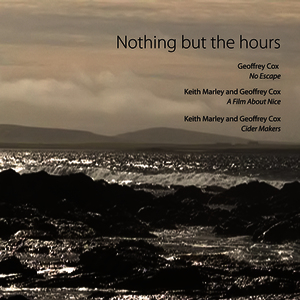No Escape (Cox, 2009-9)
No Escape is based on the concept of documentary display, an approach that encourages listening and looking rather than cognitive understanding. It conveys a belief in the supremacy of sound and in the idea of film as a performance, as witnessed in the days of early cinema when ‘silent’ films were accompanied not only by live musicians but by live sound effects troupes.
The title refers to the idea that though we may travel to get away from something, there is no escape from the inner life. This is represented by the piano music, which varies within fairly restricted limits and though it does respond to or drive image choice and editing, the overall sense should be that one cannot escape and these responses are temporary and fleeting. The sense of movement and traveling does provide a very loose narrative (and harks back to the early travelogues of the silent film era) but there is no specific story being told.
There is a personal subtext being worked out in No Escape – the attempt to escape is real. I shot most of the images alone on various journeys around the UK and Ireland using a variety of cameras of greatly differing quality. Keith Marley assisted with some footage shot in Liverpool and offered valuable editing advice.
The general idea is that understanding and ‘knowledge’ for the viewer / listener is gleaned via a poetic, sensual engagement with sound and image. This understanding therefore may vary widely.
A Film About Nice (Marley and Cox, 2009-10)
The inspiration for this documentary came from the City Symphony filmmakers of the early 20th Century. Artists such as Walter Ruttman, Joris Ivens, Jean Vigo and Dziga Vertov created dazzling vignettes of everyday activity in some of Europe’s great cities, including those of Berlin, Amsterdam, Nice and Odessa. Their aim was not to present ‘facts’ about a specific place, rather they aimed to capture the rhythm and mood of everyday life and use the expressive capabilities of the editing process to invigorate and bring alive the footage that they had captured.
Whereas these early films were silent, we have utilized sound as a further way of representing the atmosphere of a place. All the sounds used here were recorded on location and they have been layered and sequenced in particular ways in order to show how one can hear, as well as see a place.
This is a film without scenario and one without a story. There is no plot, no heroes and no villains; there is, after all, nothing but the hours.
Cider Makers (Marley and Cox, 2007)
Cider Makers is a documentary filmed on location in Cornwall, England. It documents and celebrates the traditional craft of making cider by focusing on the detail of the work that goes into its production and on those who make it.
Nevertheless, the film is impressionistic rather than didactic and does not attempt to educate the viewer into how cider is made; rather it tries to create a sense of the listener ‘being there’ by placing particular emphasis on the evocative nature of sound to create richer and deeper levels of meaning. All the sounds used in the film were recorded on location in the cider makers’ workplace or the local environs and whilst at times they correspond to some of the images seen, they often follow their own path, heralding images yet to be viewed, echoing those that have passed or even hinting at those that are never shown.
Downloads
Downloads per month over past year

![CoxNothing.jpg [thumbnail of CoxNothing.jpg]](https://eprints.hud.ac.uk/12067/1.hassmallThumbnailVersion/CoxNothing.jpg)

 CORE (COnnecting REpositories)
CORE (COnnecting REpositories) CORE (COnnecting REpositories)
CORE (COnnecting REpositories)